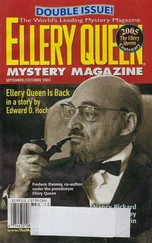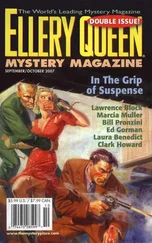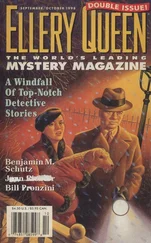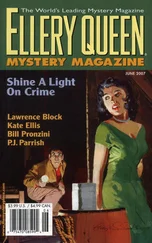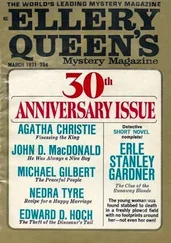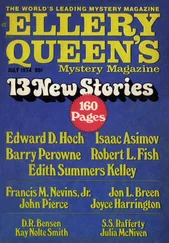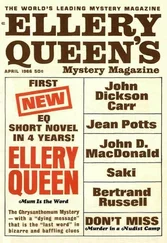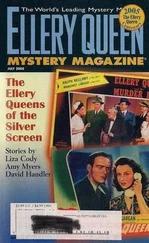Эдвард Хох - Ellery Queen’s Mystery Magazine. Vol. 130, No. 1. Whole No. 791, July 2007
Здесь есть возможность читать онлайн «Эдвард Хох - Ellery Queen’s Mystery Magazine. Vol. 130, No. 1. Whole No. 791, July 2007» весь текст электронной книги совершенно бесплатно (целиком полную версию без сокращений). В некоторых случаях можно слушать аудио, скачать через торрент в формате fb2 и присутствует краткое содержание. Город: New York, Год выпуска: 2007, ISBN: 2007, Издательство: Dell Magazines, Жанр: Детектив, на английском языке. Описание произведения, (предисловие) а так же отзывы посетителей доступны на портале библиотеки ЛибКат.
- Название:Ellery Queen’s Mystery Magazine. Vol. 130, No. 1. Whole No. 791, July 2007
- Автор:
- Издательство:Dell Magazines
- Жанр:
- Год:2007
- Город:New York
- ISBN:0013-6328
- Рейтинг книги:4 / 5. Голосов: 1
-
Избранное:Добавить в избранное
- Отзывы:
-
Ваша оценка:
- 80
- 1
- 2
- 3
- 4
- 5
Ellery Queen’s Mystery Magazine. Vol. 130, No. 1. Whole No. 791, July 2007: краткое содержание, описание и аннотация
Предлагаем к чтению аннотацию, описание, краткое содержание или предисловие (зависит от того, что написал сам автор книги «Ellery Queen’s Mystery Magazine. Vol. 130, No. 1. Whole No. 791, July 2007»). Если вы не нашли необходимую информацию о книге — напишите в комментариях, мы постараемся отыскать её.
Ellery Queen’s Mystery Magazine. Vol. 130, No. 1. Whole No. 791, July 2007 — читать онлайн бесплатно полную книгу (весь текст) целиком
Ниже представлен текст книги, разбитый по страницам. Система сохранения места последней прочитанной страницы, позволяет с удобством читать онлайн бесплатно книгу «Ellery Queen’s Mystery Magazine. Vol. 130, No. 1. Whole No. 791, July 2007», без необходимости каждый раз заново искать на чём Вы остановились. Поставьте закладку, и сможете в любой момент перейти на страницу, на которой закончили чтение.
Интервал:
Закладка:
The disappearance had been a three-day wonder in the Chicago papers and then subsided, giving way to other horrors and outrages. Kim wondered if the address given for the girl’s parents could possibly still be valid. It wasn’t. The current owner had no idea where Mrs. Raines had gone.
“Just Mrs. Raines?”
Kim gave the first name.
“Who did you say is calling?” The question was wary.
“I represent the college that Catherine Raines attended. We are trying to get in touch with our graduates.”
“Why don’t you ask at the St. Basil rectory?”
The house in which the Raineses had lived was in St. Basil parish, but great changes had taken place in the past few years. The church itself was as big as a basilica; it would have dwarfed the cathedral downtown. The rectory was equally imposing, and there was a school and convent as well, conveying a period of remarkable growth in the church—a time of ethnic pride, with neighborhoods and parishes unabashedly devoted to one immigrant group or another.
The current pastor was black, a native of Nigeria. He looked at Kim with large soft eyes and when he realized that she was a nun, was even more courteous. Father Tzenga was here to preside over the slow demise of St. Basil’s. There was now only one Sunday Mass in the huge church, and it was sparsely attended. The descendants of the original founders of the parish had fled to the suburbs. The parish school went on, taking the pressure off the local public school.
“The cardinal wants to close St. Basil’s, Sister.”
Kim wondered if the records of the parish would become as difficult to trace as those of their college. She told Father Tzenga that she was looking for a Mrs. Raines, a former member of the parish, who had lived at such and such an address. The priest just smiled at her.
“I have no idea.”
“There are no records?”
“They would tell you the woman was a member of the parish. You already know that.”
“But where would she have gone?”
“You must ask her children.”
Kim stood. At the moment the dusty paths of medieval history seemed more promising than the recent history of the city of Chicago.
“You could ask at Little Flower,” the priest suggested.
Little Flower was a nursing home two blocks away, run by the nuns who had once taught in St. Basil’s school. Their patients were largely old parishioners. The place was bright and fragrant and happy. And when she asked for Mrs. Raines the answer was immediate.
“Ward B,” the nun behind the counter said. She was peering at the cross pinned to Kim’s lapel.
“The Order of Martha and Mary.”
“Ah.”
At the end of the corridor there was a large windowed room in which old people sat in wheelchairs, ignoring television, enjoying the sun, looking placidly out the windows at the neighborhood in which they had lived their lives. Mrs. Raines was a prim little woman in her eighties. Her silver hair seemed freshly shampooed, her color was good, and her eyes shone with intelligence. She listened to Kim’s explanation of her visit as if her mornings were filled with such callers. But her daughter’s name sent a swift look of pain across her face.
“But how is Sister Mary Teresa?”
“I should have brought her with me.”
“You must do that next time.”
“Tell me about your daughter.”
Old Mrs. Raines looked at Kim. “I will soon be reunited with her.”
When Kim returned to the house on Walton Street, Emtee Dempsey was in her study. A book was open in her hand. She lifted a hand and then read aloud.
Ten wise maids with oil supplied
When asked to share they all replied,
The bridegroom comes, go buy your own.
Does wisdom look to self alone?
She looked at Kim through her rimless glasses. “Now that is an interesting view of the scriptural parable.”
“Hannah Fence?”
She waved the book in reply.
“What is the answer?”
“It wasn’t selfishness but concern for the bridegroom.”
“I have spoken with Catherine Raines's mother.”
The old nun put down the book. “Tell me about it.”
Kim recounted the visit with the thoroughness the old nun expected.
“You might mention it to Raymond.”
Raymond was Kim’s brother, a detective lieutenant in the Chicago police department.
“Are you serious?”
“Sister, I am always serious.” But she smiled sweetly when she said it.
3.
The newspaper accounts of the disappearance of Catherine Raines stressed the mystery rather than suggesting any explanation. Hannah Fence, identified as the missing girl’s best friend, was described as inconsolable. And there was a matter-of-fact quotation from history professor Sister Mary Teresa Dempsey: “A young woman does not simply disappear.” One reporter sought possible motivations for Catherine simply to run away, but such curiosity died with the story. Within a week, Catherine Raines had disappeared from newspaper accounts much as she had disappeared from the campus.
At Emtee Dempsey’s suggestion, Kim went to the little bookstore owned by Hannah Fence on Rush Street, where she found the poet in her office at the back of the store.
“Any luck?” she asked Kim.
“I have talked with Mrs. Raines.”
Two hands covered Hannah’s mouth and rounded eyes looked over their fingertips. “She’s still alive?”
“In the Little Flower nursing home.”
“I must go see her.”
Hannah’s office was a pleasant place, three walls covered with bookshelves. It was here that she had been photographed by the Tribune. It was studying that photograph that had prompted Emtee Dempsey to ask Kim to visit the poet.
“The newspaper accounts are so dissatisfying.”
“I know. Sister, it was the most frustrating event of my life. Catherine and I were very close. There was scarcely an issue of Fennel and Rue that did not contain something of hers while I was editor.”
“And yet she couldn’t come up with an entry for the Mundelein Prize.”
“Inspiration is an unreliable friend.” It might have been a mantra.
“Who won the prize that year?”
“I did! But what pleasure could I take in that after what had happened to Catherine?”
“It was good of you to dedicate your book to Catherine.”
“It was the least I could do.”
“I wonder if Catherine would have gone on writing poetry.”
A clerk looked in to tell Hannah that a customer wanted her to autograph her little book of poems. She left the office with a pleased expression, excusing herself. Kim stood and examined the shelves in Hannah’s office. She met the poet in the shop and thanked her for seeing her.
“Must you go?”
“I’m afraid so.”
“When I went to Sister Mary Teresa I had the mad thought that, after all these years, she would solve the riddle of Catherine’s disappearance.”
“Perhaps she will.”
“Why do you say that?”
“Out of blind loyalty.”
After a moment, Hannah laughed. “How satisfying it must be to live with such a woman.”
“That’s what she tells me.”
A little bell tinkled when Kim went out the street door. She could easily walk to the house on Walton Street and she did, wondering what Emtee Dempsey would make of the result of her visit to Hannah’s bookstore.
“Well?” The old nun put down her huge fountain pen and looked at Kim.
“You were right. She has a complete bound set of Fennel and Rue on the shelf in her office.”
Emtee Dempsey took from a drawer the Tribune story on Hannah Fence the poet and studied the accompanying photograph. “I was sure that was what it was.”
Читать дальшеИнтервал:
Закладка:
Похожие книги на «Ellery Queen’s Mystery Magazine. Vol. 130, No. 1. Whole No. 791, July 2007»
Представляем Вашему вниманию похожие книги на «Ellery Queen’s Mystery Magazine. Vol. 130, No. 1. Whole No. 791, July 2007» списком для выбора. Мы отобрали схожую по названию и смыслу литературу в надежде предоставить читателям больше вариантов отыскать новые, интересные, ещё непрочитанные произведения.
Обсуждение, отзывы о книге «Ellery Queen’s Mystery Magazine. Vol. 130, No. 1. Whole No. 791, July 2007» и просто собственные мнения читателей. Оставьте ваши комментарии, напишите, что Вы думаете о произведении, его смысле или главных героях. Укажите что конкретно понравилось, а что нет, и почему Вы так считаете.

